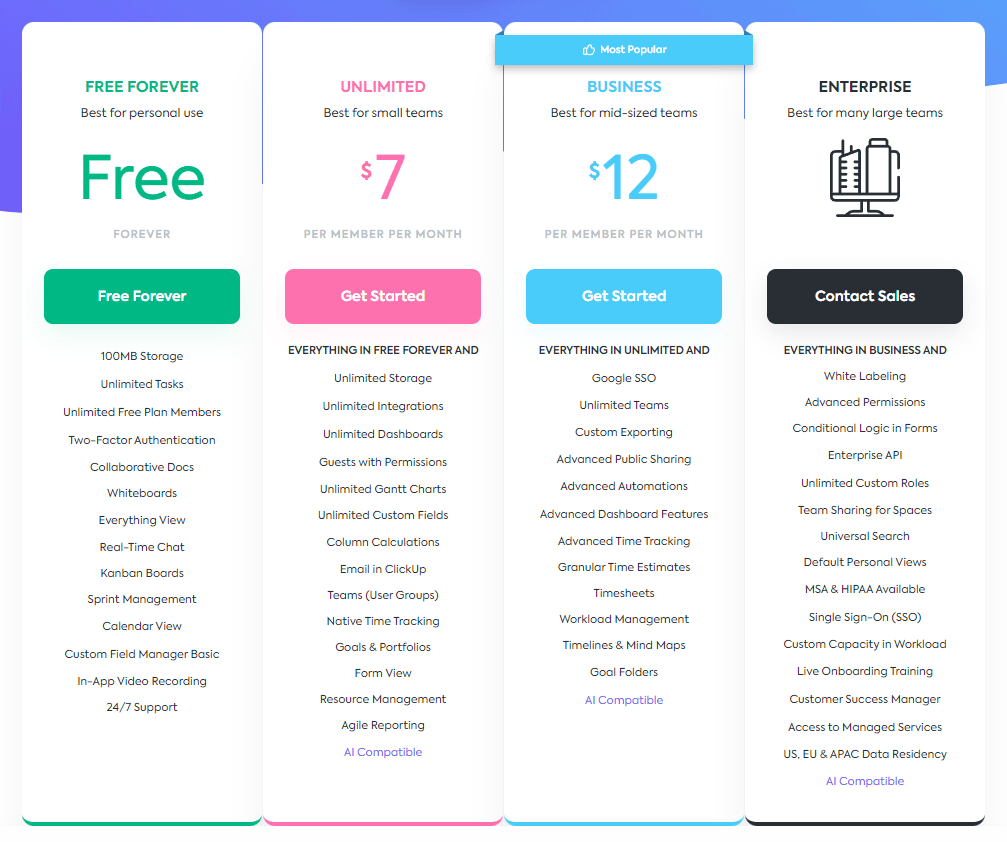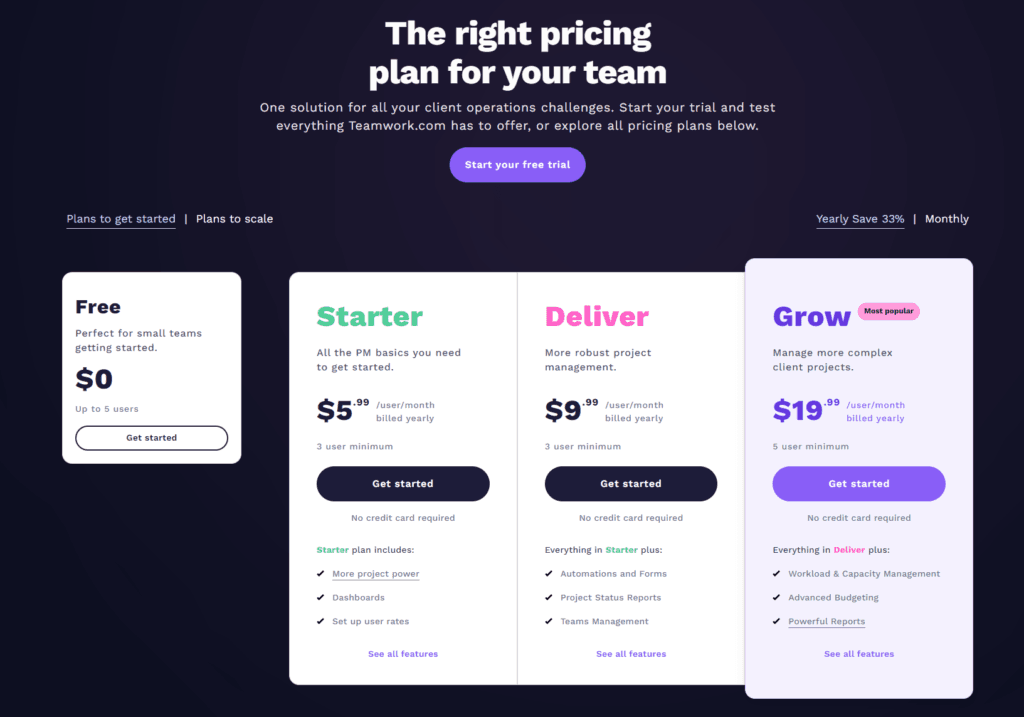In today’s fast-paced world, where every second count and efficiency is the name of the game, choosing the right project management tool can feel like picking your favorite star in the sky. Tricky, right? But don’t worry, we’re here to help shine a light on that decision-making process. Today, we’re pitting two giants against each other: ClickUp vs. Teamwork. Both platforms have their loyalists and their unique strengths, but which one will be the champion for you?
ClickUp | Teamwork |
|---|---|
| G2 Score – 4.7 out of 5 stars | G2 Score – 4.4 out of 5 stars |
| TrustRadius Score – 8.5/10 | TrustRadius Score – 7.9/10 |
User Experience (UX) and Ease of Use.
ClickUp: The Flexible Powerhouse
First up, let’s talk about ClickUp. It’s like the Swiss Army knife of project management tools – packed with features, yet it somehow manages to stay sleek and not too intimidating. ClickUp prides itself on being “one app to replace them all,” and for a good reason. Whether you’re managing a small team or an entire enterprise, ClickUp offers a deeply customizable experience that can adapt to your project’s needs. But with great power comes great responsibility, or in this case, a learning curve.
The UX in ClickUp is vibrant and colorful, which can make your project management experience feel a bit more fun and less like a chore. Navigating through its myriad of features can be a bit daunting at first, but once you get the hang of it, it’s like having a superpower. ClickUp offers various views for your tasks and projects, including lists, boards, calendars, and even a mind map. This flexibility ensures that no matter how your brain is wired, you’ll find a way that works best for you.
But let’s not sugarcoat it – ClickUp’s abundance of features and customization options can overwhelm newcomers. It’s like being handed the keys to a spaceship when you only need to drive to the supermarket. However, for teams willing to climb the learning curve, ClickUp becomes an invaluable asset that can be tailored to fit nearly any project management style.
Teamwork: The Intuitive Collaborator
On the flip side, we have Teamwork. Imagine walking into a well-organized room where everything has its place – that’s the vibe Teamwork gives off. It’s designed with clarity and simplicity in mind, making it a hit for teams who want to hit the ground running without getting bogged down by too many bells and whistles. Teamwork offers a straightforward approach to project management, making it accessible for users of all skill levels.
The user experience in Teamwork is clean and intuitive, with a focus on getting things done efficiently. It doesn’t bombard you with endless customization options, but it still offers enough flexibility to manage your projects effectively. Teamwork’s interface is easy on the eyes and easy to navigate, making it a breeze for new team members to get up to speed.
While Teamwork may not offer the same level of customization as ClickUp, it shines in its simplicity and ease of use. It’s perfect for teams looking for a straightforward, no-fuss project management tool that gets the job done. Plus, Teamwork has a strong emphasis on collaboration, with features designed to improve communication and teamwork without overwhelming users.
Task Management and Workflow Customization
Here, we’ll see how ClickUp and Teamwork equip teams to handle the nitty-gritty of daily tasks and manage workflows efficiently. This comparison should help you decide which tool better aligns with your team’s workflow and project management style.
ClickUp: A Tailor-Made Approach to Task Management
ClickUp takes task management to a whole new level with its highly customizable approach. It’s like giving you a block of clay and saying, “Mold it however you want.” You can create tasks, subtasks, checklists, and even add custom fields to track exactly what matters to your team. Whether you’re juggling multiple projects at once or focusing on a single, complex project, ClickUp’s flexibility allows you to tailor the platform to your exact needs.
The platform shines with its ability to adapt to various methodologies, whether you’re a fan of Kanban, SCRUM, or anything in between. ClickUp’s multiple views (List, Board, Calendar, Gantt, and more) ensure that everyone on your team can work in the way that suits them best. Plus, with Automations, ClickUp takes repetitive tasks off your plate by automating workflows, which can significantly boost your team’s efficiency.
However, with great customization comes great complexity. Setting up ClickUp to perfectly match your workflow can take time and experimentation. It’s like learning to drive a high-performance car; once you get the hang of it, the ride is smooth, but there’s a learning curve.
Teamwork: Streamlined Task Management for Efficient Teams
Teamwork approaches task management with a more streamlined, less is more philosophy. It focuses on providing a clean, user-friendly interface that makes managing tasks feel less like rocket science and more like a walk in the park. You can easily create tasks, assign them to team members, set deadlines, and track progress without getting lost in a sea of unnecessary features.
Teamwork offers a variety of views, including List, Board, and Gantt, ensuring that you have the flexibility to manage projects in a way that makes sense to your team. While it might not offer the same level of customization as ClickUp, Teamwork hits the sweet spot for teams looking for an effective, no-frills approach to task management.
One of Teamwork’s strengths is its focus on collaboration and communication within tasks. Comments, file attachments, and task history are easily accessible, making it straightforward for teams to collaborate on tasks without leaving the platform. This emphasis on simplicity and clarity helps keep teams focused and productive.

Related: Check out our free SEO suite

Collaboration and Communication
ClickUp: Centralizing Communication for Seamless Collaboration
ClickUp recognizes that communication is the lifeline of any project. It endeavors to centralize communication within the platform, making it easier for team members to collaborate without jumping through hoops (or apps, for that matter). With ClickUp, you can comment directly on tasks, mention teammates to grab their attention, and even create dedicated spaces for discussions. This means that whether you’re hashing out the details of a task, asking for updates, or brainstorming ideas, it all happens in one place.
But ClickUp doesn’t stop there. The platform also includes features like Docs, where you can create and share documents with your team, collaborate in real-time, and link directly to tasks and projects. This integration of task management and documentation ensures that all relevant information is easily accessible, fostering a more collaborative environment.
Additionally, ClickUp’s Whiteboard feature takes brainstorming to a new level, allowing teams to visually map out ideas and plans. This can be particularly handy for creative processes, strategic planning, and problem-solving sessions. The idea here is to make collaboration not just possible but intuitive and engaging.
Teamwork: Streamlining Communication to Enhance Team Productivity
Teamwork approaches communication with a similar goal but executes it in a way that emphasizes simplicity and effectiveness. It offers a clean and straightforward messaging system that integrates seamlessly with task management. This ensures that conversations can be easily linked to specific tasks or projects, reducing confusion and keeping everything organized.
One of Teamwork’s standout features is its ability to create task-specific threads. This means that every discussion about a task stays with that task, making it easy to track decisions, feedback, and updates. It’s a simple yet effective way to ensure that communication is organized and contextual.
Furthermore, Teamwork places a strong emphasis on email integration. Understanding that email is still a primary communication tool for many, Teamwork allows you to update tasks, add comments, and even create new tasks directly from your email. This feature is a nod to the reality of our workflows, offering flexibility and convenience to those who aren’t quite ready to leave their inbox behind.
Integrations and Extensibility
ClickUp: The Integration Powerhouse
ClickUp positions itself as a highly versatile platform, not just in terms of what it can do on its own, but also in how it integrates with a myriad of other tools and services. Recognizing the diverse needs of teams and the variety of tools they use, ClickUp offers an extensive library of integrations with popular apps and services. From communication tools like Slack and Microsoft Teams to file sharing services such as Google Drive and Dropbox, ClickUp ensures you can connect your digital work ecosystem seamlessly.
Moreover, ClickUp’s robust API opens the door for custom integrations, allowing teams with the technical know-how to tailor the platform even further to their unique needs. This level of flexibility is a boon for teams that rely on a mix of standard and niche tools for their operations.
Teamwork: The Efficient Connector
Teamwork may not boast the same extensive list of integrations as ClickUp, but it focuses on providing seamless connections with the tools that teams use most. It offers integrations with major productivity tools like Google Drive, Dropbox, and Slack, ensuring that the basics of team collaboration and file sharing are well covered.
Additionally, Teamwork’s integration with time tracking and invoicing tools like Harvest and QuickBooks appeals to agencies and client-focused teams, streamlining the process from project management to billing. Like ClickUp, Teamwork also provides an API for custom integrations, offering flexibility for teams with specific needs.
Pricing
ClickUp:

ClickUp is known for its flexible pricing structure, designed to accommodate everyone from individual users to large enterprises. One of ClickUp’s most attractive features is its generous Free Forever plan, which offers a substantial array of features at no cost. This plan is ideal for small teams or individual users just starting with project management tools, providing a risk-free way to explore ClickUp’s capabilities.
As your team grows or your needs become more complex, ClickUp offers several paid plans, including the Unlimited, Business, and Enterprise levels. Each tier adds more features, more integrations, and higher limits on usage, allowing you to scale your toolset alongside your team. The pricing for these plans is competitive, especially considering the depth and breadth of features ClickUp offers at each level.
Teamwork:

Teamwork’s pricing model is straightforward and transparent, with a focus on providing value at every tier. Like ClickUp, Teamwork offers a Free Forever plan, albeit with more limited features compared to ClickUp’s offering. This plan is suitable for small teams or startups looking to get a taste of what Teamwork can do without committing to a paid subscription.
For more advanced features and larger teams, Teamwork’s paid plans include Pro, Premium, and Enterprise options. Each tier unlocks additional features and capabilities, with clear distinctions between what each plan offers. Teamwork’s pricing is competitive, and the company frequently highlights the value that each tier provides, making it easier for potential users to understand what they’re paying for.
Conclusion
As we wrap up our comprehensive dive into ClickUp versus Teamwork, it’s clear that both project management tools offer robust features designed to streamline workflows, enhance collaboration, and boost productivity for teams of all sizes. The journey through their user experiences, task management capabilities, collaboration and communication features, integration potentials, and pricing structures reveals distinct advantages in both platforms, catering to a variety of user needs and preferences.
ClickUp stands out for its unparalleled flexibility, extensive customization options, and a generous free plan that’s hard to beat. It’s the tool of choice for teams looking for an all-in-one solution capable of adapting to complex workflows and diverse project management needs. With its vast array of integrations and powerful automation features, ClickUp is designed to grow alongside your team, making it a solid investment for startups and large enterprises alike.
Teamwork, on the other hand, shines with its user-friendly design, straightforward pricing, and a focus on efficient task management and communication. It offers a more streamlined approach, ideal for teams seeking clarity and simplicity without sacrificing functionality. Teamwork’s integration with key tools and focus on providing a cohesive platform make it a strong contender for teams that value a balance between features and usability.
Read Next:
- Sprout Social vs SmarterQueue: The Best Social Media Management Tool for You
- Agorapulse vs Social Report: The Best Social Media Management Tool for You
- SendPulse vs EmailOctopus: The Best Email Marketing Tool for You
- SendPulse vs Stripo: The Best Email Marketing Tool for You
- Agorapulse vs Friends+Me: The Best Social Media Management Tool for You






















Comments are closed.